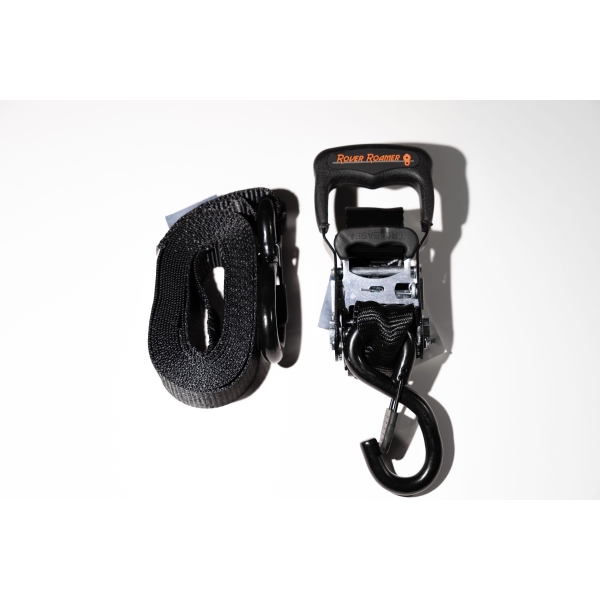Ratchet Tie-Down, 10ft
line tightener for permanent cable systems
Unit Price: $9.95
Featuring a heavy-duty 10ft, 1.5" wide strap with 3000 lbs strength, the Ratchet Tie-Down is perfectly designed to tighten long, heavy aerial cable lines. Adding a rachet tie-down, especially in combination with a Spring Tensioner, creates a safety function for low hanging lines for unsuspecting passersby on foot, scooter, or bicycle.
The Ratchet Tie-Down should be used together with the Spring Tensioner to allow the system some flexibility to move in the natural word, which reduces the stress on the other component parts such as the Anchor Straps and alternate eye screw hardware. Weather can exacerbate this natural stress by swaying thinner trees, which you may have selected as anchor points, in even moderate wind.
The Ratchet Tie-Down is included as an option on all RoverRoamer cable systems. We recommend using it for cable lengths over 100ft when working alone.
Specs: Total Length 10ft, 1.5" polyester webbing, 3000lbs breaking strength/1000lbs working load, weather resistant, with rubberized handle and release, durable vinyl covered hooks.
Click on the Video tab below to view 3 videos: 1) The basic mechanism; 2) How to thread the strap into the center pin; and 3) How to release the straps from the center pin.
Using the Ratchet Tie-Down instead of the Turnbuckle
There are situations in which using one or more turnbuckles is just not feasible, given the length of line and whether you have help setting up the system. The Ratchet Tie-Down is weather resistant and very effective in tightening longer lines. It accomplishes this by cranking the webbing through a central pin, called a mandrel, which rolls the webbing around the pin. This shortens the strap and pulls the cable line toward the anchor point. Numerous YouTube videos and How-To sites feature instructions as well.
Quick instructions on how to thread the ratchet tie-down:
Your ratchet comes with about 10 feet of webbing. You will not be able to coil up that much webbing around the central pin; you’ll only be able to crank the ratchet about 25 times before it gets stuck. Therefore, you will first thread the webbing through the pin (mandrel) and pull out any unnecessary webbing from the other side. If you think you only need 4 feet of webbing, then pull out 6 feet of webbing from the other side.
The release button is the double finger hole that you squeeze back while pulling the webbing back. This can be tricky and often frustrating so learn it beforehand. Become familiar with this mechanism feature by trying it out a couple of time: Crank the main handle a few times and notice the central pin starting to slowly rotate. Then pull on the double webbing while pulling the release back. You don’t want to learn how to do this once you’ve gummed up the pin with too much webbing.
Once you become comfortable with the mechanism, set your length of webbing accordingly and follow the instructions below:
1. Once you’ve set the anchor straps and have attached all of the hardware onto the cable, place the ratchet between the anchor point and the spring and attach the ratchet hooks to each.
2. Pull the excess ratchet webbing through the mandrel (pin) to remove as much slack as possible.
3. Start cranking the ratchet handle, keeping an eye on the spring. Don’t over-tighten the Spring! Ratchet just enough to get the line taut. The spring will slightly stretch; 1-5 inches should be enough. Stretching the spring more than 6 inches may result in the spring losing some of its function of adding flexibility to the line. If the line is still dragging but the spring seems maxed out at 6 inches of stretch, you may need two springs placed in parallel, side by side, which will double the spring strength. We include 1 spring per 50 feet. For longer lines, two springs, side by side, will be necessary.
4. If you think you left too much webbing for the ratchet to crank, release the webbing by squeezing the smaller, inner, double-finger, rubber handle to release the ratchet webbing. You may have to adjust the cable length or the ratchet length to get the right combination length. Don’t over-crank the ratchet with too much webbing. It becomes more difficult to release when it starts rubbing against the ratchet inner hardware.



